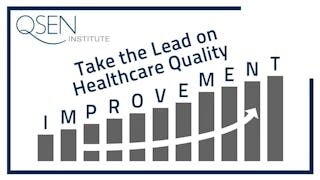In this course, you will learn about the importance of measuring the quality of care and health outcomes in order to determine whether Quality Improvement(QI ) initiatives have achieved their aims. You will learn about how data is utilised to identify areas of improvement and the importance of using both quantitative and qualitative data in evaluating change. You will learn about the specific methods appropriate for improvement as distinct from methods more suited to research, including how to design measurement schemes suitable for improvement initiatives


Using Data for Healthcare Improvement
本课程是 Quality Improvement in Healthcare 专项课程 的一部分
1,552 人已注册
包含在  中
中
您将获得的技能
要了解的详细信息

添加到您的领英档案
7 项作业
了解顶级公司的员工如何掌握热门技能

积累特定领域的专业知识
- 向行业专家学习新概念
- 获得对主题或工具的基础理解
- 通过实践项目培养工作相关技能
- 获得可共享的职业证书

该课程共有4个模块
In this module, you will learn about the importance of measuring quality of care and health outcomes in order to determine whether QI initiatives have achieved their aims. You will learn about how data is utilised to identify areas of improvement and the importance of using both quantitative and qualitative data in evaluating change. You will learn about the specific methods appropriate for improvement as distinct from methods more suited to research, including how to design measurement schemes suitable for improvement initiatives.
涵盖的内容
4个视频10篇阅读材料2个作业1个插件
In this module you will learn how to use the methods of statistical process control to distinguish between variation due to changes in the underlying process of care and variation that is part of this process, including how to distinguish when variation in a measure constitutes evidence of improvement in care. You will use the statistical software package R to analyse real time series data using Shewhart charts, and learn to interpret and act on the results. Example data is taken from a project screening for Atrial Fibrillation in an at risk population, and data on time spent in the accident and emergency department
涵盖的内容
1个视频2个作业5个非评分实验室
In this module you will build on what you learnt previously, expanding the repertoire of methods to cover additional types of data frequently encountered in quality improvement.
涵盖的内容
1个视频1篇阅读材料1个作业2个非评分实验室
In this module, you will learn about the use of qualitative research methods in QI in healthcare. This includes how qualitative methods can be used to drive improvement, and in studying and evaluating improvement. You will learn about the Matching Michigan study, including methods and key findings, as an example of the importance of theory in quality improvement. You will compare three theoretical frameworks for implementation and improvement, identifying their strengths and weaknesses, and use a tool designed to aid framework selection.
涵盖的内容
3个视频5篇阅读材料2个作业2个讨论话题
获得职业证书
将此证书添加到您的 LinkedIn 个人资料、简历或履历中。在社交媒体和绩效考核中分享。
位教师

从 Public Health 浏览更多内容
 状态:免费试用
状态:免费试用Imperial College London
 状态:预览
状态:预览The University of Sydney
 状态:预览
状态:预览Case Western Reserve University
 状态:免费试用
状态:免费试用Imperial College London
人们为什么选择 Coursera 来帮助自己实现职业发展




学生评论
30 条评论
- 5 stars
86.66%
- 4 stars
3.33%
- 3 stars
6.66%
- 2 stars
0%
- 1 star
3.33%
显示 3/30 个
已于 Dec 27, 2023审阅
I did not find the labs helpful. It was too distracting to find the content. I learned more from articles I pulled from the web.
常见问题
To access the course materials, assignments and to earn a Certificate, you will need to purchase the Certificate experience when you enroll in a course. You can try a Free Trial instead, or apply for Financial Aid. The course may offer 'Full Course, No Certificate' instead. This option lets you see all course materials, submit required assessments, and get a final grade. This also means that you will not be able to purchase a Certificate experience.
When you enroll in the course, you get access to all of the courses in the Specialization, and you earn a certificate when you complete the work. Your electronic Certificate will be added to your Accomplishments page - from there, you can print your Certificate or add it to your LinkedIn profile.
Yes. In select learning programs, you can apply for financial aid or a scholarship if you can’t afford the enrollment fee. If fin aid or scholarship is available for your learning program selection, you’ll find a link to apply on the description page.
更多问题
提供助学金,



